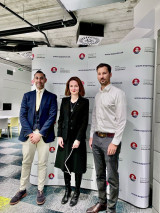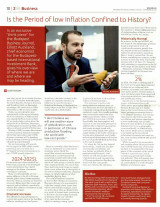IIB Chief Economist Elliott Auckland to leading Czech financial portal Roklen24.cz: "The task of central banks is to transfer us to the new reality of inflation and interest rates".
Source: https://roklen24.cz/
Global and Regional growth is heating up…
Last year we put out economic forecasts for our EU-5 Member States (Bulgaria, Czech Republic, Hungary, Romania and Slovakia) which we forecasted on average a 6% contraction in 2020, followed by a 3.8% recovery in 2021. Today, we are looking far more optimistically on the region following the 4.7% contraction in 2020, and the now expected 4.9% recovery in 2021. In particular, we are particularly positive on the prospects of the Slovakian, Romanian and Hungarian economies in 2021 all of whom could post growth of 5% this year.
Moving to 2022, we expect the economic recovery to pick-up steam as economies will be fully open without any Covid closures, consumers will be spending built up savings and strong global growth will push up export demand. We are forecasting 4.7% growth for the region in 2022, which would potentially put the region on track for a V shape recovery (returning to its pre Covid growth trajectory by 2024-2025). Those statistics are for the most part better than almost all of the developed world notably being better than the EU average as the theme of economic convergence continues.
… Leading to increasing inflation
Many countries globally are now seeing inflation prints in the 4% to 6% range (despite global central banks targeting 2% to 4%). There is currently a very large economic debate about the current and expected path of inflation, specifically, whether this inflation is transitory or part of something bigger.
The inflationary argument points to the current data points such as the headline inflation print, metals prices, food prices, as well as a dramatic increase in the number of corporates mentioning inflationary costs (for instance Berkshire Hathaway or Starbucks) or rising wages in the face of tight labour markets (such as Mc Donalds). More structurally, there has been a focus on extremely accommodative monetary policy (both the record low interest rates and the traditionally unconventional QE programs), coupled with extremely accommodative monetary policy which will take many economies above their output potential. On top of that, there has been a lot of focus on supply chain costs; either due to disruption in the semi-conductor industry, shipping issues, or simply tightening labour markets in the Far-East.
The Central Banker’s response to that is that inflation is transitory. The main drivers of it are related to individual supply chain issues which will be resolved (for example used car prices have shot up dramatically as a result of limited auto-production in the face of a microchip shortage), or, because of the one-off effect of re-opening the economy which is causing a sharp uptick in prices of services such as airline tickets and the price of entertainment. This argument is particularly strong when one assesses year on year data given the low base of effect of companies cutting prices during peak of the pandemic. Structurally speaking, many economists expect the same deflationary trends, which occurred pre-Covid to occur post-Covid. Specifically, that demographics will continue to put downward pressure on inflation (due to limited consumption and excess savings) mixed with continued cheap supply from global supply chains as the world continues to become more integrated and finally technological advancement will ensure the cost of goods fall (from microchips to the cost of energy).
So where do I sit on this debate? Structurally I do think that the days of extremely low inflation are now behind us on a global level. Predominately, because I don’t think that we will see another wave of globalization and in particular, of Chinese production flooding the world with low cost goods. Once you remove the enormous disinflationary force that China was in the equation, I think traditional forms of understanding inflation such as the Phillips Curve will return.
As a result, by the end of 2022 on the back of strong and coordinated economic growth we will begin to see inflationary pressure build as such that will require global policy makers to tighten monetary policy somewhat. Here, I want to caveat that I do not foresee something too extreme, rather a return to what has been historically normal; with a 10 Year US Treasury yield returning to somewhere in the 3% to 4% range by late 2022 early 2023. Meanwhile in Europe, 10 Year Bunds moving towards 1% in the same time period, towards 2% by 2024. The shift on the long-end of the curve will be quite a large shift compared to where we are today and to what investors, corporates and consumers have got used to. Central Banks as such will have a very challenging task of moving us calmly to a new inflation and interest rate reality.
Specifically in the Eastern European region, inflationary forces will likely gather pace earlier than in Europe and at a similar time as with the United States and other faster growth economies, which are close to a “V shaped” recovery. The two big risks thus on the horizon are that as inflation and interest rates begin to even moderately rise globally there are some pockets of disruption (whether that be on a geographic or sectoral level) or alternatively, that Central Banks are too stubborn in recognising the new global inflationary dynamics and re-act too late, thus causing inflation and growth to over-run.
While we need to be conservative and cautious about claiming victory over Covid by the end of this year. We have to be prepared for the next phase of the economic cycle, which I think is a positive one, one of accelerating growth (both locally and globally). That will present new challenges and opportunities for us all particularly in a world of higher inflation and interest rates.


